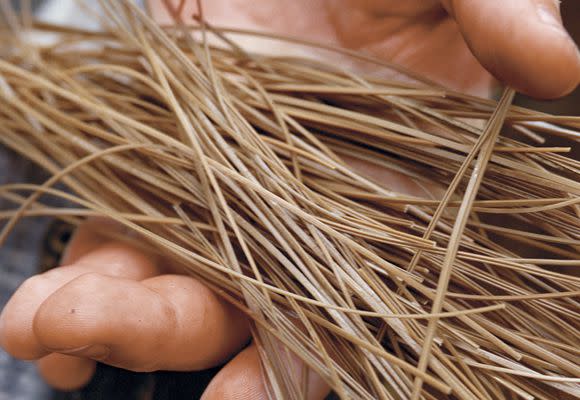Pine Straw: Why Southerners Love To Hate It
Love it or leave it—it’s all over the South

If you live just about anywhere in the South, there’s a high chance you’ve dealt with utterly annoying and never-ending pine needles. Depending on the type of tree you have, they begin to shed in spring or summer till fall. Those needles may be a nuisance as they blanket your yard, but they do have some usefulness in your landscape. We know pine straw is easy to hate, but here’s why you may want to rethink it.
Why Southerners Hate Pine Straw
My relatively small front yard is home to two towering pines, and each time the needles fall, my yard appears completely brown. The first time I came home to this, I thought, “What happened to my grass! How did it all die over the weekend?” only to realize it was just covered in pine needles. With my meager rake and essentially powerless blower, I attempted to rid my yard of the matter. After hours of back-breaking work raking and blowing the pine straw into the beds, my yard still had a brown tint. Needless to say, I now loathe pine straw. The only benefit of being fortunate enough to have pine trees on your property is an overabundance of material to cover your flower beds. Love it or hate it, it’s an unending supply!
The irony of its abundance is that many people still purchase the stuff, including Travel and Culture Editor Tara Massouleh McCay’s husband. “Love-hate is definitely a good way to describe my household’s relationship with pine straw. My husband clearly loves it—as evidenced by the truckloads of the stuff he has delivered to the house twice a year. I, on the other hand, hate it, especially when I get the credit card bill for hundreds of dollars for something you can find on the ground,” she says.
Why Southerners Love Pine Straw
Despite the nuisance of working with pine straw, it has a lot going for it. Covering your beds with pine straw is an instant way to boost curb appeal and protect your plants, but the biggest difference between the South and other regions is that we typically use pine straw in lieu of mulch. “Apparently, the fact that we use pine straw is crazy,” says Associate Editor Mary Shannon Wells.
Though endless falling pine needles can be a pain point for many homeowners, it has a few upsides—the biggest being that pine straw is less expensive than mulch and easy to spread and rearrange with no tools. Pine trees across the region shed their needles throughout the year so often that you can find pine straw free of cost (like Grumpy does) in your own yard, or you likely have a nearby neighbor who will gladly allow you to take some of theirs. Whether it’s coming from your yard or a garden store, pine straw is an environmentally friendly choice because no trees have to be cut down in the process.
The rich, reddish color of fresh pine straw brings life and contrast to your garden which is ideal for boosting curb appeal. One of its benefits is preventing evaporation of water from the soil, and it helps reduce weed growth in beds while also keeping erosion at bay. A thick layer will protect plants during winter. It also works well in the South because it naturally adds acidity to the soil as it decomposes, which many varieties found around the region thrive on—azalea bushes, rhododendrons, camellias, zinnias, dahlias, and marigolds, to name a few.
How To Buy Pine Straw
When buying pine straw for your yard, consider the type. Long needles, like those of longleaf pine, are easier to collect, last longer, take longer to deteriorate, and stay in place better than shorter, denser types like loblolly and slash pine. Their red color is more appealing to some gardeners than the lighter brown varieties, but it is usually more expensive than other types.
Pine straw is considered a crop, so the best time to get it is when it’s freshly harvested in late fall or winter. If you have pine trees in your yard, don't toss them. Rake up the needles to mulch your flower beds.
When To Spread Pine Straw
Typically you’ll need to refresh your beds with the covering once a year, twice to keep it extra fresh, but if you have very needle-generous trees in your yard, chances are you might be adding a fresh layer a bit more often. When spreading pine straw, it's not necessary to remove the old pine straw. It will decompose. Just make sure to add enough fresh pine straw so the total depth is no more than three inches.
Love it or hate it—you can’t escape pine straw in the South.
Frequently Asked Questions
What are the disadvantages of pine straw?
Pine straw is flammable, so take caution when using it near your home. Do not use it around grills or fire pits. Pine straw is also acidic, which some plants may not like.
Why do people use pine straw instead of mulch?
There are several reasons people may choose pine straw over mulch. Pine straw lasts longer than mulch because it breaks down more slowly. Because pine straw is lighter than mulch, it is easier to spread. Mulch can attract pests such as termites, and some lightweight mulch may wash away when it rains. Some gardeners prefer the uniform color of pine straw.
What month is the best time to put pine straw down?
January and February are the best times to put pine straw down to help protect plants from freezing winter temperatures. It can be spread anytime of year though. Many gardeners prefer to put it down in spring and fall.
For more Southern Living news, make sure to sign up for our newsletter!
Read the original article on Southern Living.
